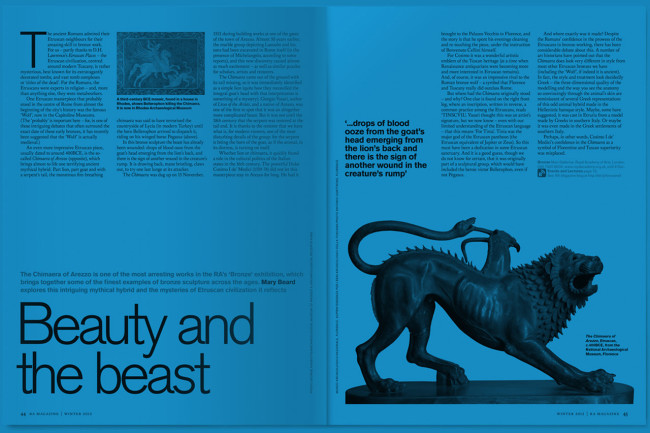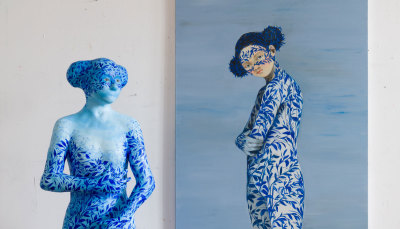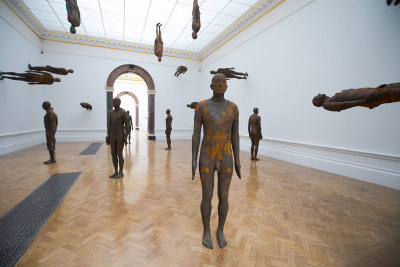Degas, dolls and life drawing: Cathie Pilkington in the RA Schools
Degas, dolls and life drawing: Cathie Pilkington in the RA Schools
By Amy Sherlock
Published 23 March 2017
Cathie Pilkington RA is transforming the RA Schools’ life drawing room with an installation of uncanny figures inspired by Degas’ sculptures. Amy Sherlock finds out more about the project.
-
From the Spring 2017 issue of RA Magazine, issued quarterly to Friends of the RA.
You’re the new Professor of Sculpture at the RA Schools and you’re working on a new installation for the RA Schools’ life drawing room. What will be in the installation?
I’ve made a new series of sculptures called Degas Dolls for the Life Room. Much of my recent work either incorporates or refers to doll parts. While the Degas Dolls don’t contain any found doll parts, the works are meant to evoke objects like tailors’ dummies and rag-dolls.
The objects I make are constructed from separate parts. This is central to my work. I might make six heads and ten pairs of legs to begin with. I do this by stitching together cloth to make at shapes, like pattern cutting for clothing, and I then fill these with plaster: the forms become three dimensional in a really satisfying way. They’re like a cross between prosthetics and doll limbs. Interestingly, I have just been to see the Rodin exhibition at the Courtauld Gallery – his dancing figures were made using a similar technique of recombining separately cast limbs.
How do you connect the different body parts?
I work out how I want to position the limbs and then build a traditional armature – a kind of wire skeleton – which supports the wet clay I sculpt to join them. It’s time consuming. I have to feel my way through the form: it has to be believable but strange enough to be interesting. I want the figures to have a kind of impossible anatomy. When I am happy with the clay form, the entire work is cast.
This process makes reference to the Surrealists’ parlour game Cadavre Exquis, or Exquisite Corpse, in which words and images are assembled haphazardly. The first series of these figures, Lady Dolls, which I made in 2012 for a show at the V&A Museum of Childhood, mixed women’s bodies with dolls’ heads. A lot of the things that happen in my work start with the material – its particularity, its associations. Material has emotional as well as formal qualities. I like the confusion between the different elements in Lady Dolls: there is always a certain ambiguity about what is made and what is found.
Where do you find your dolls?
I find them on eBay or at car boot sales. I steal them from people, including my daughter! When I choose a doll, I’m after something very particular, rather than something that looks generic. Often, the doll slips between being an adult and a child.
In the same way that Degas’ dancers are somewhere between innocence and provocation?
Yes. Degas’ Little Dancer Aged 14 (c.1881) has always been a really important object for me. There is something exciting about the artifice of patinated bronze dressed in real clothing – it seems like a completely contemporary figurative sculpture. My new Degas Dolls series refers directly to the artist’s smaller sculptures of dancers. Those works are very famous now, but they were cast posthumously – they were only ever made for reference, as studies. The way they were built is fascinating. When they were X-rayed, much later, it was discovered that they are cobbled together with bits of cork, string and wire. There’s no proper anatomical armature that a trained sculptor would have used in that period: he was going about things in a way that I can relate to and often do myself.
-

The RA Schools’ Life Room, with its display of historic casts, which Cathie Pilkington RA plans to work with in her forthcoming installation
Photograph by Andrew Testa/Panos
-
Is scale important to your work?
Yes. The Degas Dolls sculptures are deliberately awkward because they’re too big for dolls, but too small to be statues.
The doll as a device is a fantastic, potent thing and a lot of that is a question of material and scale. Everyone who has a doll when they are growing up undresses it to look at how it’s made. You see the plastic limbs and the soft body and the perverse discrepancy between the two; you understand the false naturalism and you somehow want it to be more convincing. I think everyone has had that kind of experience with objects that pretend to be real.
I am leaving the Degas’s Dolls on their armatures in the installation because I want to prevent them being too autonomous or alive; they’re not supposed to be believable in that way. That’s also why they don’t have faces: rather than being individuals, I want people to be able to project onto them. I am interested in the tension between subject and object.
How will the figures be installed?
The work will engage with the theatricality of the Academy’s Life Room, its history and its use. I want the room to feel inhabited by the sculptures, which will appear to be “in progress”. The installation will also include a proliferation of objects, drawings and studio equipment: I often make reference to the material process of making in my installations.
I will also work with the Life Room’s display of historic casts. The casts are a particularly dominant and important feature of the room, and they’re mostly male figures. I’m going to dress, drape, protect or obscure them with soft coverings.
Will visitors be able to see the installation?
The RA Schools is usually closed to the public, so people will be able to visit the Life Room in timed ticketed tours. They will be guided by an RA Schools student through the back entrance of the Schools – the whole thing will have a “back of house” feel to it, which is in keeping with the work and gives an insight into the life of the Schools.
You are also leading a two-day masterclass within the installation. What will you do there? The masterclass is called Exquisite Corpse.
We are going to spend the first day making drawings and collages based around the installation and on the second day we are going to be building figures in clay and other materials. There will be a lot of invention, collaboration and chance involved.
The installation will be restaged in Brighton. How will it be different there?
The installation will be shown in the University Gallery as part of Brighton Festival. It will be in a large room with windows onto the street, like a huge shop front. I will work with students to build a set, a “ghost image” of the RA’s Life Room.
The University Gallery is a very different space. At the RA I think the figures will seem tiny but vibrant against the lush velvet curtains and wooden benches. In Brighton, they’ll seem much more vulnerable and exposed.
Life Room: Anatomy of a Doll is installed in the Life Room of the RA Schools, 1–14 April 2017.
Cathie Pilkington discusses her project in an artist talk, 1 April 2017.
Exquisite Corpse, a masterclass with Cathie Pilkington RA, 8–9 April 2017.
-
-
Enjoyed this article?
Become a Friend to receive RA Magazine
As well as free entry to all of our exhibitions, Friends of the RA enjoy one of Britain’s most respected art magazines, delivered directly to your door. Why not join the club?

-





